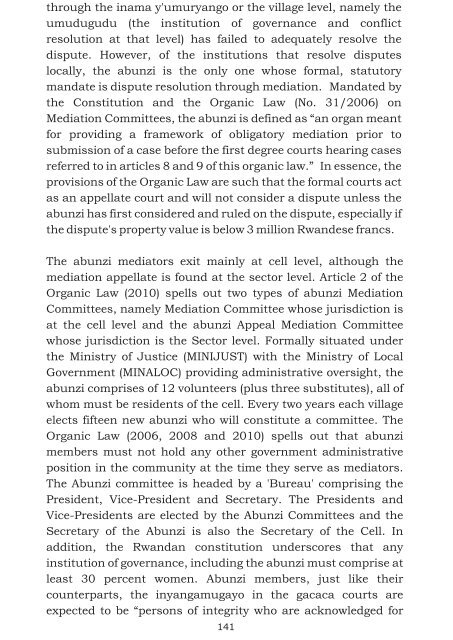Beneficiaries are actors too.pdf - Southern Institute of Peace ...
Beneficiaries are actors too.pdf - Southern Institute of Peace ...
Beneficiaries are actors too.pdf - Southern Institute of Peace ...
You also want an ePaper? Increase the reach of your titles
YUMPU automatically turns print PDFs into web optimized ePapers that Google loves.
through the inama y'umuryango or the village level, namely the<br />
umudugudu (the institution <strong>of</strong> governance and conflict<br />
resolution at that level) has failed to adequately resolve the<br />
dispute. However, <strong>of</strong> the institutions that resolve disputes<br />
locally, the abunzi is the only one whose formal, statutory<br />
mandate is dispute resolution through mediation. Mandated by<br />
the Constitution and the Organic Law (No. 31/2006) on<br />
Mediation Committees, the abunzi is defined as “an organ meant<br />
for providing a framework <strong>of</strong> obligatory mediation prior to<br />
submission <strong>of</strong> a case before the first degree courts hearing cases<br />
referred to in articles 8 and 9 <strong>of</strong> this organic law.” In essence, the<br />
provisions <strong>of</strong> the Organic Law <strong>are</strong> such that the formal courts act<br />
as an appellate court and will not consider a dispute unless the<br />
abunzi has first considered and ruled on the dispute, especially if<br />
the dispute's property value is below 3 million Rwandese francs.<br />
The abunzi mediators exit mainly at cell level, although the<br />
mediation appellate is found at the sector level. Article 2 <strong>of</strong> the<br />
Organic Law (2010) spells out two types <strong>of</strong> abunzi Mediation<br />
Committees, namely Mediation Committee whose jurisdiction is<br />
at the cell level and the abunzi Appeal Mediation Committee<br />
whose jurisdiction is the Sector level. Formally situated under<br />
the Ministry <strong>of</strong> Justice (MINIJUST) with the Ministry <strong>of</strong> Local<br />
Government (MINALOC) providing administrative oversight, the<br />
abunzi comprises <strong>of</strong> 12 volunteers (plus three substitutes), all <strong>of</strong><br />
whom must be residents <strong>of</strong> the cell. Every two years each village<br />
elects fifteen new abunzi who will constitute a committee. The<br />
Organic Law (2006, 2008 and 2010) spells out that abunzi<br />
members must not hold any other government administrative<br />
position in the community at the time they serve as mediators.<br />
The Abunzi committee is headed by a 'Bureau' comprising the<br />
President, Vice-President and Secretary. The Presidents and<br />
Vice-Presidents <strong>are</strong> elected by the Abunzi Committees and the<br />
Secretary <strong>of</strong> the Abunzi is also the Secretary <strong>of</strong> the Cell. In<br />
addition, the Rwandan constitution underscores that any<br />
institution <strong>of</strong> governance, including the abunzi must comprise at<br />
least 30 percent women. Abunzi members, just like their<br />
counterparts, the inyangamugayo in the gacaca courts <strong>are</strong><br />
expected to be “persons <strong>of</strong> integrity who <strong>are</strong> acknowledged for<br />
141


